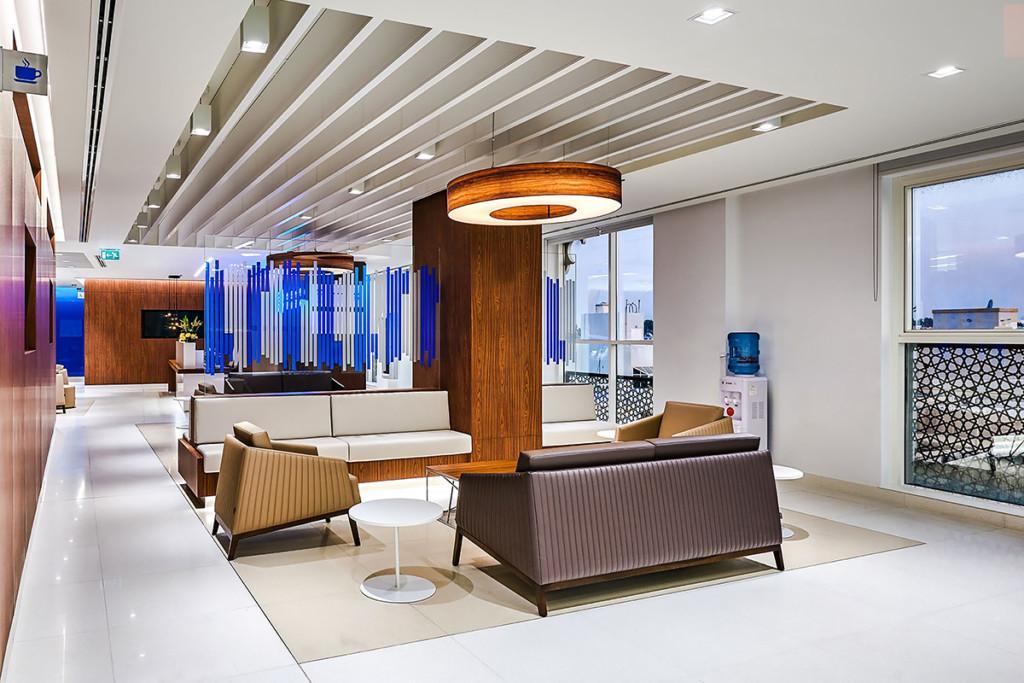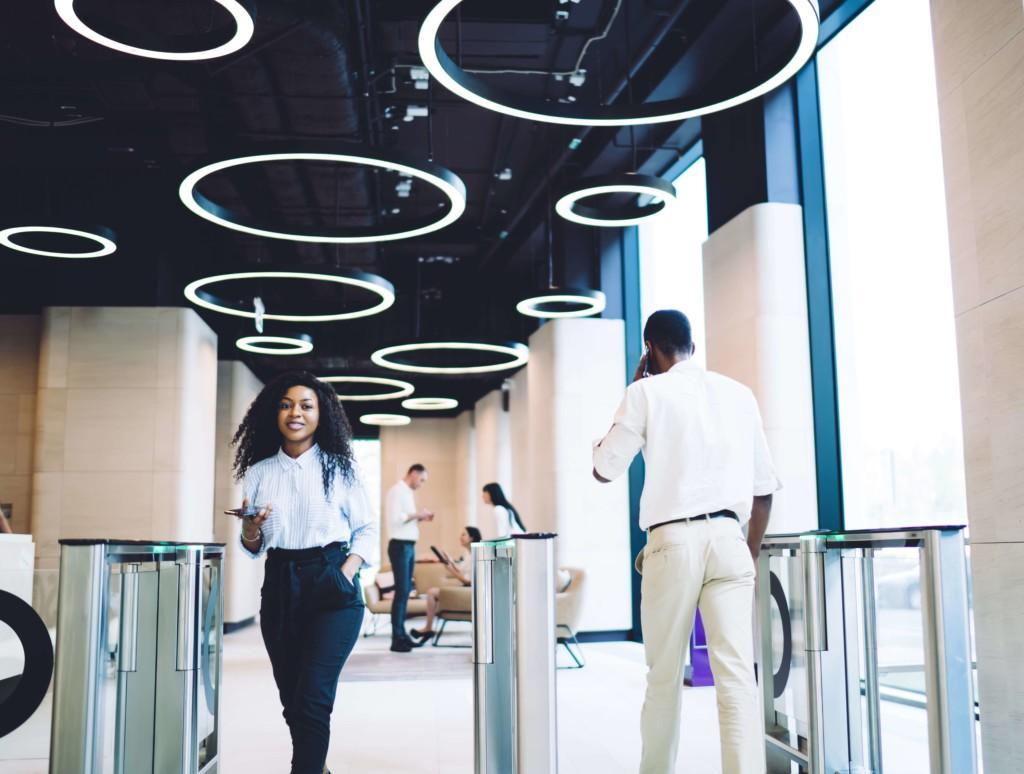![]()
What are lighting controls?
At their core, lighting controls regulate the intensity of light and the color temperature in an area.
Using modern, intelligent lighting controls unlocks a wide range of benefits ranging from energy efficiency to user comfort to space adaptability. Lighting controls are particularly valuable when they can also interact with other building systems and provide useful data insights for users of the space.

Intelligence allows lighting controls to provide enriched sensing data and interact with other building systems, creating a seamless experience for everybody.

User comfort can be optimised through lighting controls that bring flexibility to our ever-changing buildings, and that can cater for the individual needs of people in different spaces.

Energy savings are a core outcome of lighting controls, helping us all to minimise costs, achieve building standards and reach critical sustainability targets.
Lighting control technology has changed greatly over the years!
![]()

The evolution of controls
Manual inputs were the first method through which we could ‘control’ lighting, and to this day, remain the most basic and widespread form of lighting control. Beginning with the humble light switch in the late 1800s, and progressing to dimming switches from the 1950s, manual forms of lighting control continue to be often used in residential spaces, for example. Dimming allows users to control the level of light output beyond the simple ‘on’ or ‘off’ capabilities of the light switch, which helps create different light scenes and save energy.
In the late 1990s, open protocols like DALI began to emerge, allowing for communication between individual components of a lighting system. DALI (and DALI-2) continue to serve as open standards for lighting, bringing the benefit of improved interoperability and allowing lighting systems to interact with components from different manufacturers, e.g. with a wide range of luminaires. Lighting control companies can also provide different system functionalities on top such standards.
Following advancements in wireless communications, lighting controls have also begun to utilise such technology. In wireless lighting, control signals between different devices are communicated through radio waves instead of low-voltage hardwiring. Wireless devices communicate within a mesh, where adding, removing, and replacing devices is both easy and secure. In smart lighting, the wireless mesh is typically based on a low-power, short-range radio technology, most commonly Bluetooth Low-Energy (BLE).
![]()
![]()
![]()

Lighting automation and ‘Human Centricity’
As with many other technologies, automation has come to play an important role in lighting control systems. The use of various sensors, for example, allows us to automatically switch on and control levels of light within specific areas, based on inputs like movement, IR radiation or sound. Software and applications are now an accessible technology in both commercial and residential settings, bringing a broad range of possibilities to configure the behaviour of lighting control systems.
Lighting control systems automate the lighting to deliver a comfortable user experience while reducing energy usage, by utilising functionalities such as daylight harvesting and occupancy detection. Through scheduling, different lighting profiles, and setting the lighting in a such a way that it works in harmony with our body’s natural circadian rhythms, there are new opportunities to improve user experience. The concept of Human-centric lighting focuses on the benefits of improved mood, productivity and concentration¹ that can be achieved through lighting.
![]()
![]()
![]()

Lighting Intelligence
Intelligent lighting controls can create a seamless and personalised lighting experience for everyone, through a combination of data insights, innovative technologies and Human-Centric design. For example, digital services can process valuable data obtained from lighting controls to provide insights regarding space usage, device maintenance and overall efficiency. By coordinating with building technologies like HVAC and blinds, intelligent lighting controls can provide optimal conditions at the right time for any number of different actions or events.
Artificial intelligence in lighting control systems has introduced a new level of comfort and ease-of-use, allowing spaces to ‘learn’ and adapt to patterns in behaviour, as well as changes in usage. Ultimately, by combining wired and wireless intelligent lighting technologies, we can create hybrid spaces with the ‘best of both worlds’ of lighting control, which serve to maximise efficiency and wellbeing while helping to reach critical sustainability targets.
![]()
![]()
![]()

The evolution of controls
Manual inputs were the first method through which we could ‘control’ lighting, and to this day, remain the most basic and widespread form of lighting control. Beginning with the humble light switch in the late 1800s, and progressing to dimming switches from the 1950s, manual forms of lighting control continue to be often used in residential spaces, for example. Dimming allows users to control the level of light output beyond the simple ‘on’ or ‘off’ capabilities of the light switch, which helps create different light scenes and save energy.
In the late 1990s, open protocols like DALI began to emerge, allowing for communication between individual components of a lighting system. DALI (and DALI-2) continue to serve as open standards for lighting, bringing the benefit of improved interoperability and allowing lighting systems to interact with components from different manufacturers, e.g. with a wide range of luminaires. Lighting control companies can also provide different system functionalities on top such standards.
Following advancements in wireless communications, lighting controls have also begun to utilise such technology. In wireless lighting, control signals between different devices are communicated through radio waves instead of low-voltage hardwiring. Wireless devices communicate within a mesh, where adding, removing, and replacing devices is both easy and secure. In smart lighting, the wireless mesh is typically based on a low-power, short-range radio technology, most commonly Bluetooth Low-Energy (BLE).
![]()
![]()
![]()

Lighting Automation and Human Centricity
As with many other technologies, automation has come to play an important role in lighting control systems. The use of various sensors, for example, allows us to automatically switch on and control levels of light within specific areas, based on inputs like movement, IR radiation or sound. Software and applications are now an accessible technology in both commercial and residential settings, bringing a broad range of possibilities to configure the behaviour of lighting control systems.
Lighting control systems automate the lighting to deliver a comfortable user experience while reducing energy usage, by utilising functionalities such as daylight harvesting and occupancy detection. Through scheduling, different lighting profiles, and setting the lighting in a such a way that it works in harmony with our body’s natural circadian rhythms, there are new opportunities to improve user experience. The concept of Human-centric lighting focuses on the benefits of improved mood, productivity and concentration¹ that can be achieved through lighting.
![]()
![]()
![]()

Lighting intelligence
Intelligent lighting controls can create a seamless and personalised lighting experience for everyone, through a combination of data insights, innovative technologies and Human-Centric design. For example, digital services can process valuable data obtained from lighting controls to provide insights regarding space usage, device maintenance and overall efficiency. By coordinating with building technologies like HVAC and blinds, intelligent lighting controls can provide optimal conditions at the right time for any number of different actions or events.
Artificial intelligence in lighting control systems has introduced a new level of comfort and ease-of-use, allowing spaces to ‘learn’ and adapt to patterns in behaviour, as well as changes in usage. Ultimately, by combining wired and wireless intelligent lighting technologies, we can create hybrid spaces with the ‘best of both worlds’ of lighting control, which serve to maximise efficiency and wellbeing while helping to reach critical sustainability targets.
![]()
![]()
![]()
Lighting controls bring value to many spaces…
Lighting controls play a critical role in office spaces by supporting our individual productivity and collective wellbeing, all while contributing to a seamless office experience.
Benefits of lighting controls for office spaces include:
• Workplace health and productivity
• Personalisation and adaptability
• Achieving building standards

Good light feeds growing minds. Lighting controls help learners stay sharp by efficiently balancing natural daylight with human-centric lighting design. It’s a prize-winning formula for concentration, wellbeing and budgets!
Benefits of lighting controls for educational facilities include:
• Comfort for students and staff
• Correct lighting levels for diverse activities
• Integration with building management and audio-visual systems

In healthcare settings, lighting controls provide comfort for staff and patients through circadian design, personalisation and automation. Intelligent lighting systems provide even more value through insights on space utilisation and overall system health.
Benefits of lighting controls for healthcare include:
• Simple control for patient comfort
• Task lighting for medical personnel
• Fully scalability, from a bed to the whole building

Design and comfort are the cornerstones of hospitality, where lighting controls shine by offering endless possibilities for customisation. Create the perfect guest experience through dynamic lighting systems that provide full control over a variety of different spaces.
Benefits of lighting controls for hospitality include:
• Limitless customisation
• Ease of use for guests and staff
• Seamless experiences through automation and intelligence

Preserving our cultural landmarks is an important task, often with complex requirements for lighting. Lighting control systems help to create beautiful illuminations with minimal headache in design and setup.
Benefits of lighting controls for cultural applications include:
• Customisable lighting scenarios
• Integrations with other systems
• Simple scalability

In industrial facilities, operations must be precise and efficient with minimal downtime. Apart from bringing significant energy savings, intelligent lighting controls can help proactively identify maintenance issues for a quick resolution.
Benefits of lighting controls for industrial applications include:
• Lighting optimised for productivity
• Real-time monitoring and maintenance
• Energy and cost savings

Whether it comes to the largest cruise ships in the world or to your local supermarket, intelligent lighting control systems can provide impactful benefits for a vast array of spaces.
• For marine applications, lighting controls enable stunning lighting scenes for the ultimate entertainment experience. Regardless of scale, intelligent lighting systems can offer seamless control over the entire vessel.
• For retail applications, a comfortable shopping experience is paramount. Lighting controls create flicker-free conditions and help to highlight everything that is on offer, while allowing the lighting to adapt to any changes within the space.
• For transport applications, delivering proper lighting at the right time is key to operational efficiency. By integrating with other systems in the premises, intelligent lighting controls bring automation and comfort to new levels.

Get to know lighting controls


Human-Centric Lighting
The concept of Human-Centric Lighting (HCL) refers to lighting design that is specifically focused on the health, wellbeing and performance of humans. Intelligent lighting controls embrace this concept by fine-tuning the system to our needs, regardless of where we work, learn or relax.






